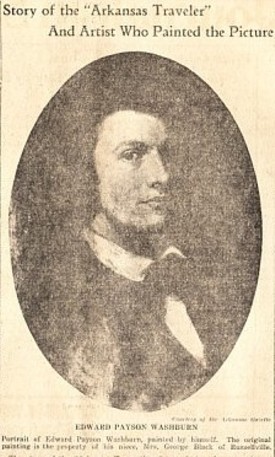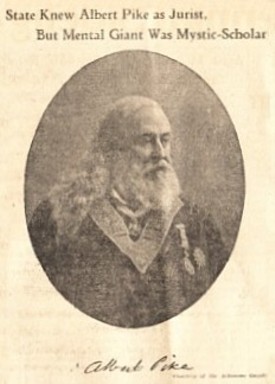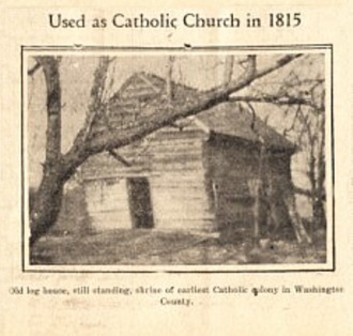Factory Here
Says Sen. Wilson
-------**-------
From a tanyard toapproximately
25 factories, large and small, is the history of Fayetteville's man- ufacturing growth, which came out of Callahan's tanyard, which once stood on the lot below the Big Spring on Willow street, according to R. J. Wilson of Fayetteville. A man named Col-
lins a short time later opened a tannery on "Sherry street," close to the present line of Gregg street.
Among the city's earliest plants
was a tobacco factory operated by Columbus Jackson, the grandfather of Homer Jackson, Senator Wilson stated. As a boy Mr. Wilson here earned his first money. The building stood on the corner of Spring and Block streets. It was operating as late as 1860, but was shut down during the Civil War.
-------**-------
HAWTHORNE SCHOOL
(Continued from page 10)
Burl D. Battle became an assoc- iate justice of the supreme court of Arkansas. David Polson married the daughter of the Cherokee Indian Chief John Ridge and became brigade surgeon for General Stanwaite during the Civil War. John
Arrington, son of Alfred,became
son-in-law to Congressman Greenwood and rose to rank of Colonel in the Civil War. Arkansas Wilson was a captain in the Confederate Army through the War J. R. Pettigrew, lawyer of ability, was one of the manipulators in locating the Uni-
versity of Arkansas here. He, too, was a colonel in theConfed- erate Army, and held a post at Washington one year. He was appointed to the Utah Com- mission and died in harness, being succeeded by Brice
Williams.
John R. Wilson was a justice at
Farmington. John M. Pettigrew was connected with Arkansas College for eight years, married a Miss Aldridge of Franklin county and became one of the ablest teachers of his time.
Four of the young women graduates became teachers. One, Kate Smith, became daughter-in-law of Governor Yell who fell at Buena Vista at the head of his regiment, in the Mexican War. The daughter of
one of these Hawthorne students became wife of a president of the University of Arkansas who later went to Washington to Congress for the longest stay in Arkansas' history, Judge John N. Tillman.
Hugh F. Thompson went to the
legislature and served four years as Confederate Congressman. L. Denton missed but five days from school, became minister and educator and was elected state superintendent of schools, finally coming to an untimely death here at the home of Judge
Lafayette Gregg. Will Engles of the picture founded the town of Farmington during the Civil War, now site of the Arkansas branch of Stark Brothers nursery which has 500 acres there and which recently purchased the Burbank Gardens in California.
One of the first teachers was
Malilla E. J. Murphy, daughter of the "accidental provisional governor" of Arkansas, in re- construction days as he was called by A. B. Lewis. The school was of two rooms, built
of hewn logs put together with wooden pins. A pulpit was in the east end. In front of this was a mercy seat. Seats of students, without desks or backs were of dressed pine an inch thick attached to uprights of the same thickness. The stove was a large box affair, the first one many
pupils had ever seen, fireplaces having been used entirely up to this time. It was manufactured in Cincinnati, Ohio, a 93-year old student recalls, and was made by Frazier. So far as is known it was the first stove shipped to this section.
A board roof topped the log walls and the floor was of fress- ed blue-ash.
Odle, Menney, Rice, Davis and Martin K. Waller were numbered among early teachers who received $1.25 a month from each pupil and "boarded round." Each teacher carried a "pen-knife" with which to sharp- en the student's quill pens. The building pictured was 16 by 18
feet with a 12 light window in one side. Boys occupied the east side and the girls the west side of the building.
The school of 1842 took the place of one much earlier, date of which is forgotten.
-------**-------
Earliest State Paper
Off Press Nov. 20, 1819
Arkansas was the first state west
of the Mississippi to publish a newspaper, while the Arkansas Gazette was the first newspaper west of the Mississippi and the first in Arkansas. The first issue was printed Nov. 20, 1819, by William E. Woodruff.
-------**-------
The Quesenbury-Hill residence on Duncan street has painted on its walls and now covered with removable papering a painting from Quesenbury's brush, to be restored when an artist can be secured.

Courtesy of Arkansas Gazette
Portrait of Edward Payson Washburn, painted by himself. The original painting is the property of his niece, Mrs. George Black of Russellville.
| The story of the "Arkansas Traveler" is
one of the pic- turesque traditions of the state that never
fails to lure the visitor. The original paint- ing, based on the story, is in possession of Mrs. G. G. Black of Russellville, Arkan- sas, a niece of the artist, Edward Payson Washburn, son of a Fayetteville pioneer educator. The companion painting, "Turn of the Tune," illustrates the cordial spirit between the Traveler and the Arkansas natives evoked by the travel- er's fiddling. "Who wrote the 'Arkansas Traveler' its tune and its dia- lect?" is a question often asked. In the Century Magazine of March,1896, H. C. Mercer says the honor of having written the lines lies between Col. Sanford C. Faulkner of Arkansas and one Jose Tasso, Italian, born in Mexico City. It is true that the tune is based on an old Italian melody, but it is doubt ful that one not a native of the country could have caught and used so exactly the Ark- ansas squatter dialect and mountaineer brogue, so Mercer says, the credit probably goes to Col. Faulk- ner. In 1840, so the story goes, Faulkner, traveling in the Boston mountains in this section, came with a party which included Archibald Yell of this place, A. H. Sevier, Chester Ashley and William S. Fulton, upon a cabin of a mountain squatter, where, according to others of the party, Col. Faulkner "passed some banter" with the squatter and later played his fiddle. From this time, the words and music of the "Arkansas Traveler" were associated with Col. Faulkner. The words of the piece, according to Charles T. Davis, however, may be a collection taken at large from the connected narrative of a single event. Passages vary, having to do with repairs on the roof of a leaky cabin which doesn't matter when it doesn't rain and which can't be fixed when it does. Whoever wrote the words and music, there is no doubt of the authenticity of the painting, based on the tale. Edward Payson Washburn painted |
the picture during the year 1858 at Norristown,
Pope county. His father, Rev. Cephus Washburn, a Presbyterian or
Congrega- tional minister and an incorpor- ator of the Far West
Seminary incorporated here November 30, 1844. Mr. Washburn, Sr., came here from Yale in 1821 to found somewhere in this section a Cherokee school. The Washburn family was one of the earliest English families on American soil and is noted in history for its many distinguished sons and daughters. Members of the family, who spell their name Washburne and Wash-borne, have added lustre to American art, politics, law, religion and education with each generation. Founder of the Far West Semi nary, Mr. Washburn became pastor of the Presbyterian church at Fort Smith and his daughters, Mrs. George Black of Russellville and Mrs. C. W. Dodd of Pope, still reside in the state. In the son's painting, the Trav- eler is Col. Faulkner, drawn from memory and daguerreo-type, and is considered a good likeness. The artist, himself a scholar and classicist and his learning was not confined to art. In literature his taste was exquisite and he could recite whole orations of Cicero and the epic cantos of Homer to lyric accompaniments of a mountain brook "deep in the heart of a wilderness as utter as those of Caesar's writings," as C. T. Davis puts it. -------**------- Washington Court House Until August 29, 1829 Fayetteville had a postoffice be- fore 1828 but not in her present name. Until August 27, 1829, the office here where mail was received for the whole county section was addressed to "Wash -ington Court House," this postoffice, it is said, antidating even that of Cane Hill. Change in the name of this locality came about during the first administration of Andrew Jackson whose relatives and descendants still reside here and who include the Homer Jackson family generation and the Futrall children. -------**------- Ozark orchards were first planted by pioneers for the pur-pose of brandy-making. |
==========================================

"The Turn of the Tune," companion piece to the Arkansas Traveler painting illustrates the cordial spirit evoked by the Traveler's fiddling. The painting was stolen and taken north during the Civil War. Its companion picture is still in possession of Mrs. George Black of Russellville, neice of the artist, Edward Payson Washburn.
==========================================
Budd Fence Post
Co.
Pioneers in Own Field,
Largest in the World
By Means Wilkerson
Starting with one carload of fence posts, which he himself cut, E.
A. Budd has continually increased his business until now the Budd Fence
Post company is said to be the largest of the kind in the world.
Over 10,000 carloads of posts have been cut and shipped by Budd in
the last 20 years--enough to make a fence 100,000 miles long.
Budd sells fence posts over practically the entire country, yet his
greatest sales come from the plains regions of Kansas, Nebraska, and
Oklahoma. In and near Fayetteville and in the neighboring shipping
points, the tracks are lined with stacks of hardwood posts.
Besides being the largest fence post shipping company in the world,
the business of Mr. Budd has the distinction of being, as far as he
knows, the first one of its kind in the world.
-------**-------
John R. Rainwater, father of Mrs. Sally Rainwater Chryst of
Fayetteville, secured the large pillars which still make the entra- nce
to the main building of the University. Mrs. Chryst was pre- sent at the
University corner-stone laying and later attended
the University.

Courtesy of Arkansas Gazette
| The Homer of America, the
Zoroaster of modern Asia, a profound philosopher, a great
jurist, a great phiologist, a profound enthologist, and a great
statesman, Albert Pike, one of the greatest men who ever lived in Arkansas, was a frequent visitor to Fayette-ville. A friend of Judge David Walker, Archibald Yell and William Quesenbury, Pike was entertained and feted here at the homes of both. He was intimate with a number of other Fayetteville jurists. Although he is famous as a soldier, statesman, jurist and poet Pike's greatest achieve-ments were in the realm of literature and learning. He was well known as a poet, having appeared in the fam-ous Blackwood's Magazine at one time with a 600-line poem. There was a turn of mysticism in his almost flaw- less verse, which rings with all the bell-like quality so familiar in that of Poe. As a scholar, Pike is almost with-out equal even today. Justinian, the great Roman emperor, caused a com-pilation of 50 volumes, in the sixth century, of the decisions, writings, and opinions of the old Roman jurists, "The Pendects of Justinian." Gen- eral Pike read this com-pilation in the Latin tongue and translated a great part of it into English in writing, and had read all the works in Civil law by Latin and French authors of any celebrity. "His work on the Maxims of French and Roman law is in itself a great achievement," says his biographer. Not content with this, Pike plunged deeper into a more ancient and more mystic literature. Some idea of his vast accomplishments may be gained from his herculean labors during a decade in which he translated and com- mented on the Rig Veda and Zend Avesta and other works of Aryan literature. The Rig Veda is a compilation of the same character of sacred literature of the Persian sages. This great work of General Pike's attained the dimensions of 15 manuscript columns. It required a profound know-ledge of ethnology and philol- ogy, and of Sanskrit and all other fossilized languages of the Aryan family nations. But this was no dry and dusty scholar whose fingers trembled over archaic pages of a forgotten past. The pict- ure of him at 40, now on ex-hibit at the Centennial muse- um here and owned by Miss Sue Walker of Fayetteville, shows him a vigorous giant, |
keen, alive, and awake to the problems of his
day. Pike was active in the early history of his state. He served with same struggle in which his friend, Governor Archibald Yell of Fayetteville, fell at the battle of Buena Vista. Later, in May, 1861, he joined the Confederacy and succeeded in recruiting a brigade of Cherokees, which he led in the battle of Pea Ridge. Pike was a great Masonic leader, grand commander of the thirty-third degree of the Scottish Rite Masons, the provincial grand master of the grand lodge of the Royal Order of Scotland, and the most eminent Mason in the western hemisphere, and per- haps, the world. As a scholar he was hot-headed and impulsive, and once fought a duel with John S. Roane which ended, how- ever, with a reconciliation of both parties, who later be- came the best of friends. The quarrel arose out of Pike's criticism of Roane's conduct in the Mexican War, in which the death of Archibald Yell embittered the great poet-soldier. Pike was born in Boston December 29, 1809. He was reared at Newburyport of the same state. He entered Har- vard in 1824, but left in 1825, and later educated himself through the junior and senior years while teaching. In March, 1831, he went west, and from St. Louis with a trading party to Sante Fe. In September,1832, he joined a trapping party at Taos and went down the Pecos river and into the Staked Plains, where he, with four compan- ions left the main party and on December 10, 1832, reached Fort Smith. In Little Rock he was assistant editor of the Advo- cate. In 1835 he bought the Advocate, shortly after his marriage. Meanwhile he had been to the bar, and rose rapidly in his profession. He was a Whig and but for his politics could have held the state in the hollow of his hand. His strict conscience, how- ever, prevented him from changing parties, and his merit did not need this to add to his fame. -------**------- The Yell andirons are owned by Mrs. Charles Appleby and are used at her historic home on Dickson Street, a hospital during the Civil War. -------**------- Mrs. J. F. McClure and Mrs. Robert Jackson, both descen- dants of Governor Archibald Yell, will tomorrow unveil the marker pplaced at the Yell home. |
==========================================
| CATHOLIC CHURCH COUNTY'S EARLIEST; WAS BUILT IN 1815 ------- OLD, weather-beaten, sur- rounded and protected by a grove of weather-beaten oaks and hickories, there stands on a farm three miles from Fay-etteville city limits the log cabin believed to be the first church erected in Washington county, and that is known to be the oldest church in the county still standing. Erected in 1815, the building is being visited as one of the points of interest in the cele-bration of "100 Years of Fayetteville," which opened July 4 with an historic parade and century of much of the history of the entire North-west Arkansas section. It was residence of the William Flynn family and adjoined the site of the 400 acres of land granted to the Roman Catholic church for a |
colony in 1844 when Rev. John Corry, coming
into Northwest Arkansas, sought to establish a colony of Irish
Catholics. The priest had been sent here by the Right Rev.
Bishop Byrne, first bishop of the diocese of Arkansas, who had
been elevated to the Episcopacy of St. Patrick's Cathedral in
New York City and appointed to the newly established See at
Little Rock. Jim Brannon, man from whom the land was bought, told the purchasers that the house had been erected in 1815. The priest became a circuit rider and the Brannon-Flynn residence was used as a church building. That portion used by the family has fallen down but the room actually used as a church stands, honored relic of early faith, appearing as below in a picture taken by J. H. Field, local art-photographer. |
